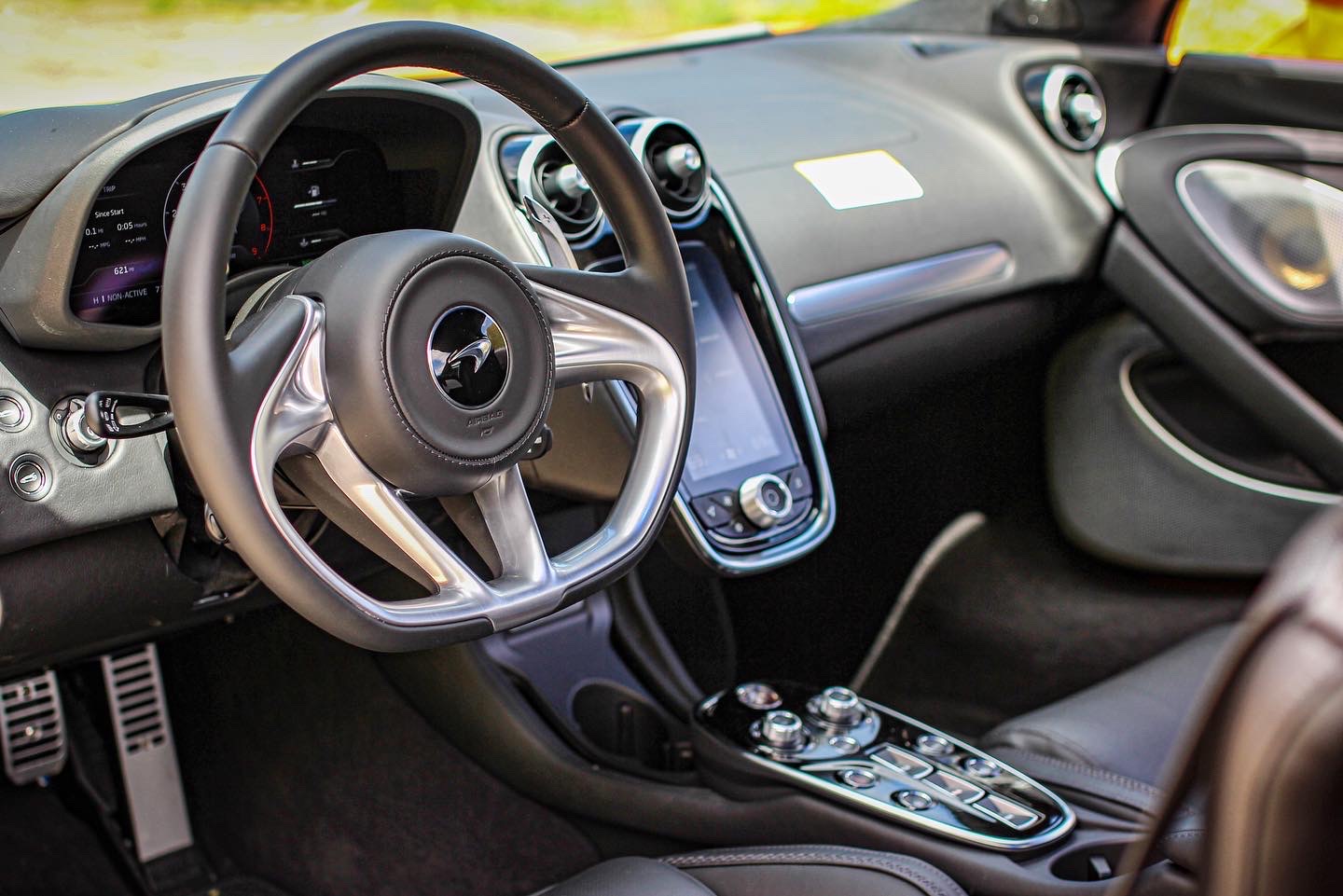There’s a reason the term “daily driver sports car” exists. It’s because typically, purpose-built performance cars suffer from an inherent lack of usability: they’re loud, uncomfortable and they require pristine driving conditions. What’s more, they’re often bereft of the accessories we’ve grown used to, and when they’re included, they’re usually subpar.
These might sound like small concessions for the chance to drive a top-tier performance vehicle, but try spending upwards of $200,000 on a car that makes you miserable half the time. Thanks to improvements in technology and manufacturing, the line between sport and luxury is blurrier than ever.
Making fun cars more accessible is a good thing, but they should at least feel different from your daily commuter. Few modern sports cars distinguish themselves like this better than ones from McLaren Automotive, so much so that I was slightly worried that its latest vehicle, the McLaren GT, would lose those particular characteristics as a consequence of making the car more accommodating. While some rough edges have been smoothed out, for better or for worse, the luxury overhaul has been a bit overstated, yet the characteristic McLaren charm remains.
Nuts and Bolts
The McLaren GT is a mid-engine rear-wheel drive two-seater that acts as McLaren Automotive’s entry level model. It’s powered by a 4.0-liter twin-turbo V8, a variant of the motor found in other models across the lineup fitted with smaller turbochargers. This iteration drops the total power output, but delivers power lower in the rev band, making peak power more accessible sooner. It generates 612 horsepower and 465 pound-feet of torque which is routed to the rear wheels by way of a seven-speed dual-clutch transmission.
With the help of launch control, the McLaren GT can sprint from 0 to 60 in 3.1 seconds and can top out at 203 mph.
As with all McLaren cars, the GT is built on a carbon fiber chassis that contributes to its light 3,384-pound curb weight. It’s also fitted with electro-hydraulic steering, which goes a long way in delivering its distinct driving feel. It all rides on an adaptive damping system and 20-inch front wheels and 21-inch rears.
As a GT, this McLaren is meant for extended drives and thus its defining feature is the 14.8 cubic feet of storage space that sits behind the driver and on top of the mid-mounted engine.
It also features an active dynamics panel that allows drivers to customize the car’s behavior, a 1,200-watt Bowers & Wilkins sound system and the latest iteration of McLaren’s bespoke infotainment system. This is the heart of the McLaren GT’s user interface and sits in a 7-inch touchscreen in the center of the dash. Along with entertainment functions, it pairs with mobile devices via Bluetooth, gives access to a handful of car settings like ambient lighting and features HERE-powered satellite navigation.
This screen is supported by a 12.3-inch digital gauge cluster behind the steering wheel. Some of the above info is pushed to that screen such as turn-by-turn directions, though its main function is providing immediate car behavior information. The typical speedometer and tachometer are of course present, but there are also tire pressure displays and other status indicators. This screen reconfigures itself depending on drive mode to better position more vital info while in a track or dynamic setting.
The UX
The big mission statement for the McLaren GT is that it’s a better balance between the driving dynamics that McLarens are known for and creature comforts. Every sports car maker tackles this particular dish with its own recipe and for its part, McLaren Automotive goes heavy on performance and light on user-friendliness. The McLaren GT is meant to be its most approachable car yet, but thankfully, the extra dollop of refinement doesn’t overpower the distinct McLaren umami underneath.
Sliding under the dihedral doors and into the GT reveals a very performance-oriented cockpit. Two ergonomic seats are divided by a very small armrest and the sparse cabin is dominated by a leather-and-steel steering wheel flanked by two wheel-mounted paddle shifters. Behind this is the aforementioned 12.3-inch digital gauge cluster that can be accessed by one of the few stalks protruding from the steering column. The 7-inch touchscreen sits above the active dynamics panel and drive select buttons while the Bowers & Wilkins speakers stare at you from the doors like a hawk’s eye.
All of this is the first indication that the McLaren GT isn’t going to stray too far from its sports car roots: this cabin is nearly identical to the one in the 570S. Naturally, there are minor differences, including additional sound baffling. But one could go from car to car and be hard-pressed to spot them.
The next is the sensation of how purpose-built the car feels. All of the luxurious touches can’t hide the fact that you’re sitting in the carbon fiber monocell of a race-ready vehicle.
The McLaren GT doesn’t do quiet. Once the twin-turbo V8 fires up, it’s your soundtrack throughout the drive, Bowers & Wilkins be damned. From here on out, the McLaren GT demands the driver to be laser focused on the act of driving, as none of the half-minded lollygagging we’re used to doing in daily traffic will fly. The steering feedback is ample, the brakes require a very heavy foot and the haunches of the athletic-looking sports car obscures much of the rearward visibility.
When allowed to gallop, the GT is enthusiastic with its acceleration and the sensation between all the systems working to keep the McLaren on course is palpable. Its electro-hydraulic steering communicates the road’s surface conditions fluidly, and its heft gives drivers something substantial to embrace. This system combo feels more responsive to the fully-electronic power steering that we’re used to, it’s meatier and heavier, but mechanically so, not with just pre-programmed motorized resistance. Same goes for the suspension and active dampers, as it’s easy to feel every bit of the McLaren GT doing its job.
How it executes its task is also determined by the active dynamics settings. Two knobs for handling and power each have three settings, Normal, Sport and Track. Normal is the most docile settings, keeping the car’s ride as comfortable as it can be with all of the usual drive assists on, and with the engine at its most tame. Sport causes the car’s overall handling to be a touch more aggressive and relaxes some of the stability control, and it also heightens the throttle response, as well as the transmission’s affinity for lower gears. Track is the McLaren’s most aggressive setting: Handling? Rigid. Traction control? Off. Engine and transmission? Unrestrained.
One of the most wonderful attributes of the McLaren GT and indeed one that it shares with its super sibling the 570S, there is very little in the way of electronic hand-holding. This lack of a computerized safety net demands a higher application of driver skill and thus it makes crisp maneuvers very rewarding, just as it makes slip-ups nerve-wracking. Think of the experience as somewhere between a Lotus Evora and the Audi R8 V10.
Living La Vida Macca
As exciting as it is to live life on the razor’s edge with the McLaren GT, the bits in-between succumb to the usual supercar user-unfriendliness. A series of parking sensors and a backup camera make positioning the precious GT around much easier, as is a push-button nose-raising feature, which is a huge relief.
This eases some of the usual daily sports car frustrations, but the true heart of the GT’s problems lay with the in-car interface.
For as good as the car is mechanically, its in-house developed operating system is a particularly glaring weak point. McLaren knows this. Frankly, it used to be worse.
The 10-core-processor-powered “Infotainment system II” is faster and more responsive than the units found in previous McLaren vehicles. Familiar swipes and pinch-and-zoom functions make using the touchpad easy, though finding the desired menu is another matter. More often than not, it will require a passenger-side co-pilot to give it the necessary attention or for the driver to pull off the road to sort things out. This could be something as simple as trying to select a music input source, but its most frustrating when it comes to navigation.
Despite the upgrade, the built-in system still feels far less intuitive and limited by current standards. Punch in the address and if it finds it, there are limited routes to choose from, if any alternatives. Deviate from the route and it will stubbornly insist that you find your way back long before it decides to re-route itself. There were also instances of inaccurate road data pushed our way, directing us to turn on roads that weren’t there, or sometimes not recognizing ones that were.
As the GT is not Apple CarPlay or Android Auto compatible, drivers are out of luck when it comes to alternative navigation systems like Google Maps or Waze. Indeed, the heavily-bezeled touchscreen’s size and orientation mirrors that of a smartphone, and there were many times we wished we could simply suction-cup our own phone over it just to find our way back home.
This doesn’t bode well for a car meant for long car journeys, nor does the 14.8 cubic feet of storage space function as intended. The extra room that sits atop the engine means whatever is laid across it is subject to a great deal of heat. It’s great for a couple pairs of skis but not so great for cargo such as electronics.
The McLaren GT is a true sports car and none of its down-tuning or soft appointments take away from that. In fact, it’s arguable that they don’t go far enough to substantially differentiate this car from others in the lineup or to live up to its Grand Tourer moniker. That’s certainly the case when it comes to its tech.
McLaren could’ve kept everything mechanically identical to its sibling cars and the GT could have set itself apart with a more robust, user-friendly road-trip oriented interface, easier to maps, bigger screens to facilitate easier access and 360-degree parking cameras, and more modern mobile device compatibility, just to name a few features we wished it had. As it stands, the $205,000 McLaren GT is a true entry-level sports car that sticks to the classics.
It delivers on the full experience, but in terms of tech, it’s a lateral step.





























































